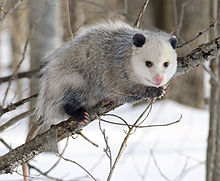Didelphimorphia
| Didelphidae Temporal range: Early Miocene–Recent |
|
|---|---|
 |
|
| Virginia opossum (Didelphis virginiana) | |
| Scientific classification | |
| Kingdom: | Animalia |
| Phylum: | Chordata |
| Class: | Mammalia |
| Infraclass: | Marsupialia |
| Order: |
Didelphimorphia Gill, 1872 |
| Family: |
Didelphidae Gray, 1821 |
| Genera | |
|
Several; see text |
|
Several; see text
The opossums, also known as possums, are marsupial mammals of the order Didelphimorphia /daɪˌdɛlfᵻˈmɔːrfiə/). The largest order of marsupials in the Western Hemisphere, it comprises 103 or more species in 19 genera. Opossums originated in South America, and entered North America in the Great American Interchange following the connection of the two continents. Their unspecialized biology, flexible diet, and reproductive habits make them successful colonizers and survivors in diverse locations and conditions.
The word "opossum" is borrowed from the Powhatan language and was first recorded between 1607 and 1611 by John Smith (as opassom) and William Strachey (as aposoum). Both men encountered the language at the British settlement of Jamestown, Virginia, which Smith helped to found and Strachey later served as its first secretary. Strachey's notes describe the opossum as a "beast in bigness of a pig and in taste alike," while Smith recorded it "hath an head like a swine ... tail like a rat ... of the bigness of a cat." The Powhatan word ultimately derives from a Proto-Algonquian word (*wa·p-aʔɬemw-) meaning "white dog or dog-like beast."
The opossum is also commonly known as a possum, particularly in the Southern United States and Midwest. Following the arrival of Europeans in Australia, the term "possum" was borrowed to describe distantly related Australian marsupials of the suborder Phalangeriformes, which are more closely related to other Australian marsupials such as kangaroos.
...
Wikipedia
